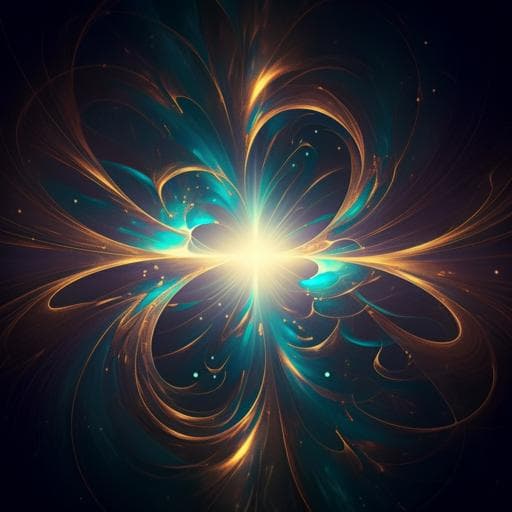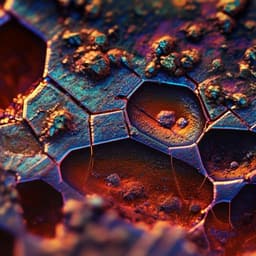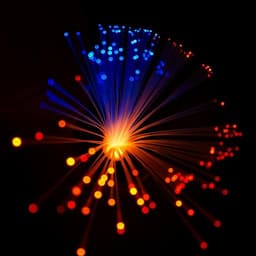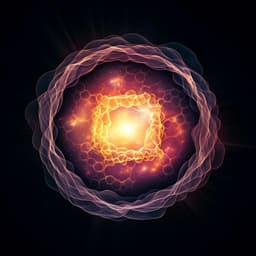
Engineering and Technology
Real-time observation of optical rogue waves in spatiotemporally mode-locked fiber lasers
U. Teğin, P. Wang, et al.
Discover the fascinating dynamics of optical rogue waves in spatiotemporally mode-locked fiber lasers, where groundbreaking research by Uğur Teğin, Peng Wang, and Lihong V. Wang reveals the power of nonlinear transformations and clean pulse generation!
~3 min • Beginner • English
Introduction
The study addresses whether optical rogue waves in fiber lasers, which have traditionally been examined only temporally in single-mode systems, can be observed and characterized in their full spatiotemporal dynamics within a spatiotemporally mode-locked multimode fiber laser. Rogue waves are extreme, rare events known from oceanography and various physical systems. Prior optical studies have largely focused on temporal intensity spikes in single-mode fibers and lasers. Spatiotemporally mode-locked (STML) multimode fiber lasers introduce coherent interactions among transverse and longitudinal modes and inherit a power-dependent spatial attractor (nonlinear beam cleaning) from graded-index multimode fibers (GRIN MMFs). The purpose is to observe, in real-time and single-shot, the spatial and temporal evolution of rogue events in an STML laser using compressed ultrafast photography (CUP), determine their statistical properties, and assess the role of the GRIN MMF attractor in shaping their spatial profiles. This has significance for understanding multimode nonlinear wave dynamics and for applications in high-energy mode-locked lasers and related spatiotemporal nonlinear systems.
Literature Review
Rogue waves, first instrumentally recorded in the ocean in 1995, have been identified across diverse systems, including optics. In optics, extreme temporal intensity fluctuations were observed during supercontinuum generation using dispersive Fourier transform, leading to extensive studies of noise-seeded dynamics and soliton behavior in single-mode fibers. Fiber lasers, with gain, saturable absorption, and dispersion, can exhibit complex nonlinear dynamics; rogue-like extreme pulses have been reported in anomalous- and normal-dispersion single-mode lasers, often in noise-like pulse or chaotic multi-pulse regimes. Spatiotemporal mode-locking in multimode fiber lasers leverages low modal dispersion and periodic self-imaging in GRIN MMFs to coherently lock multiple modes, enabling high-energy dissipative solitons, bound states, and harmonic mode-locking. A universal unstable attractor in GRIN MMFs leads to nonlinear beam cleaning and can trigger spatiotemporal instabilities at higher powers. Prior work demonstrated stable all-fiber STML lasers, self-similar propagation to improve beam quality, active intracavity wavefront shaping via genetic algorithms, and CUP-based observation of non-repeating dissipative soliton dynamics. This body of work motivates investigating spatiotemporal rogue events in STML lasers and the influence of the GRIN MMF attractor on their formation and profiles.
Methodology
Experimental: A dispersion-managed STML Yb-doped multimode fiber laser with positive net cavity dispersion (β2_net = 8240 fs^2) was constructed. The cavity used nonlinear polarization evolution (NPE) as a saturable absorber. Under relaxed saturable absorber conditions (reduced low-intensity suppression), the laser operated in a noise-like pulse regime with ~70 mW average power and ~22 MHz repetition rate. Fiber sections included a 4 m Yb-doped multimode gain fiber (10 µm core), a 2 m GRIN MMF (50 µm core), and a 1.3 m passive multimode fiber from a pump combiner (10 µm core). Multimode propagation was encouraged via 15 µm offset splicing between gain and GRIN fibers and coiling the GRIN fiber (25 cm diameter). Free-space components comprised waveplates, polarizing beam splitters, isolators, grating pairs (600 lines/mm), and a spatial filter (adjustable slit) for stability. NPE provided artificial saturable absorption. To match CUP sensitivity in the visible, the output was frequency doubled using an uncoated KTP crystal (9×9×7 mm, θ = 90°, φ = 23.4°). Angle-cleaved fiber ends mitigated back reflections. Mode-locking was self-starting via waveplate adjustment. Compressed ultrafast photography (CUP): The CUP system spatially encodes the scene with a DMD pattern, relays it to a streak camera with an open entrance slit, temporally shears the scene in the y-direction, acquires a single integrated image, and reconstructs a 3D (x, y, t) datacube using a regularization-based algorithm. Different DMD patterns enable different measurement modes. Three CUP modes were used: (1) Direct streak (plane mask) to record pulse-to-pulse temporal intensity over a 400 ns range, capturing 8 pulses per shot; 300 consecutive measurements yielded ~2400 pulses for time-series and histogram analysis. (2) Slit mask with a 1 ns time range to acquire sheared single-pulse records; the system’s temporal impulse response was measured and used for deconvolution to retrieve individual pulse shapes; 1500 pulses were collected. (3) Pseudorandom binary mask with a 1 ns time range (2 Tfps) to reconstruct single-shot spatiotemporal intrapulse dynamics; 1500 pulses were recorded, rogue pulses identified, and 3D reconstructions performed. For spatiotemporal visualization, beam-profile contours at each time point were obtained by thresholding normalized 3D intensity at 0.25 and stacking across time. Data analysis: Temporal intensities were normalized by the standard deviation σ of the time trace. Rogue wave threshold (RWT) was set at 8σ; intensities above RWT were analyzed for rarity and statistics. Spatial positions of per-pulse maximum intensity were extracted from streak images to form distributions and averaged beam profiles. 2D Gaussian fits quantified FWHM along x and y and their ratio. Individual pulse shapes were categorized by intensity relative to RWT. Statistical fitting of intensity and pulse energy distributions compared Weibull vs. Rayleigh fits. Numerical simulations: Time-dependent beam propagation in the GRIN MMF section was implemented in Python using a symmetrized split-step Fourier method with GPU acceleration. The propagation equation modeled parabolic-index guiding and Kerr nonlinearity in the GRIN MMF only. Pulses were Gaussian in time, centered at 1064 nm with 8 ps FWHM duration. The launched beam had a 1/e^2 diameter matching the 10 µm core with a 15 µm lateral offset, consistent with the experimental splice conditions. The GRIN MMF length was 2 m; the numerical step sampled each ~555 µm self-imaging period 16 times. Temporal window: 100 ps with 61.5 fs resolution; spatial grid: 64×64 with 0.84 µm sampling. Absorptive boundary conditions were enforced by truncating the parabolic index with a super-Gaussian filter. Simulations examined pulse energies equal to the average pulse energy u (u ≈ 3.2 nJ, derived from measured power and repetition rate) and scaled cases 8u and 13u, tracking beam-profile evolution after 0.5 m, 1 m, 1.5 m, and 2 m of propagation.
Key Findings
- Long-tailed non-Gaussian statistics: The temporal intensity histogram of ~2400 pulses exhibits an L-shaped, long-tailed distribution characteristic of rogue waves. Using σ-normalized intensity and RWT = 8σ, events with intensities between 8σ and 13σ occur with probability < 0.0003.
- Spatial localization and beam quality of rogue events: While noise-like pulses show widely dispersed positions of peak intensity and a broad, asymmetric average beam profile (FWHM: 164 µm x, 191 µm y; ratio 0.86), pulses exceeding RWT are tightly centered and have a more symmetric, higher-quality beam (FWHM: 156 µm x, 164 µm y; ratio 0.95).
- Temporal structure: Sub-RWT pulses display jagged, burst-like shapes. Rogue pulses exhibit clean, well-structured temporal profiles with a small pedestal. Measured FWHM pulse durations range from 7 ps to 14 ps.
- Intrapulse spatiotemporal dynamics: CUP reconstructions at 2 Tfps show that rogue pulses maintain enhanced beam quality around their temporal peaks compared to sub-RWT pulses.
- Numerical confirmation of nonlinear beam cleaning: Time-dependent beam propagation simulations in the GRIN MMF show progressive spatial beam cleaning and symmetry with increasing pulse energy (u, 8u, 13u) over 2 m propagation, consistent with a power-dependent attractor. The output beam becomes more confined and symmetric at higher energies, mirroring experimental observations of rogue events.
- Statistical modeling: Both intensity and pulse-energy fluctuations fit a Weibull distribution better than Rayleigh. Reported Weibull parameters: for intensity a = 0.536, β = 0.72; for pulse energy a = 2.07, β = 1.957.
- Operating conditions: Rogue dynamics were observed under relaxed saturable absorber conditions in a dispersion-managed STML laser (β2_net = 8240 fs^2, ~70 mW average power, ~22 MHz repetition rate).
Discussion
The results directly address the research question by revealing that rogue events in a spatiotemporally mode-locked multimode laser are not merely high-intensity noise spikes but are shaped into clean temporal pulses with improved, symmetric beam profiles. This behavior is attributed to a consistent, power-dependent spatial attractor in the GRIN MMF sections of the cavity that drives nonlinear beam cleaning. CUP-enabled single-shot, real-time measurements of both pulse-to-pulse fluctuations and intrapulse spatiotemporal structure validate that extreme events preferentially undergo this nonlinear spatial transformation. The observed long-tailed temporal intensity distributions and better Weibull fits indicate that the underlying multimode, dissipative, spatiotemporal dynamics differ from single-mode laser rogue statistics. Simulations focused on the GRIN MMF propagation corroborate this interpretation by reproducing energy-dependent beam cleaning and symmetry. Together, these findings show that the multimode nonlinear transfer function in STML lasers can convert rare fluctuations into extreme but spatially organized pulses, with implications for managing or exploiting rogue events. At still higher powers, the same unstable attractor may induce spatiotemporal instabilities, yet the resulting high-intensity pulses can retain high beam quality near their peaks, suggesting robust spatial self-organization amid extreme dynamics.
Conclusion
This work demonstrates, for the first time, real-time single-shot observation of optical rogue waves in a spatiotemporally mode-locked fiber laser, capturing both temporal and spatial dynamics with CUP. Rogue events exhibit long-tailed statistics and, unlike single-mode counterparts, produce clean pulse shapes with enhanced, symmetric beam profiles due to a power-dependent consistent attractor in the GRIN MMF that enforces nonlinear beam cleaning. Numerical simulations of GRIN MMF propagation confirm energy-dependent spatial self-organization. The findings establish that multimode nonlinear transfer functions can generate and shape rogue events, offering new insight into extreme spatiotemporal laser dynamics. Future work could explore controlled excitation or suppression of rogue events via intracavity spatial/temporal control, extend full-cavity spatiotemporal simulations including gain and saturable absorption, and investigate regimes where the attractor triggers spatiotemporal instabilities while preserving beam quality. The connections to systems modeled by the Gross-Pitaevskii equation suggest broader relevance to condensed matter contexts such as Bose–Einstein condensates.
Limitations
- Measurement constraints: CUP sensitivity in the visible required frequency doubling (KTP), which may introduce conversion-related biases and limits direct IR measurement.
- Operating regime specificity: Rogue dynamics were characterized under relaxed saturable absorber conditions in one dispersion-managed STML configuration; generalization to other laser designs and regimes requires further study.
- Attractor activation threshold: Short GRIN MMF sections in a cavity necessitate relatively high powers to realize nonlinear beam cleaning, potentially limiting accessibility of the effect across setups.
- Statistical sampling: While thousands of pulses were analyzed, the rarity of >8σ events leads to limited counts in the extreme tail, affecting estimation precision of tail probabilities.
- Modeling scope: Simulations modeled only the GRIN MMF propagation (not the full cavity with gain, dispersion management, and saturable absorption), so cavity-roundtrip effects were not explicitly simulated.
- Code availability: Reconstruction and simulation codes are proprietary and not publicly released; reproducibility relies on methodological descriptions and data upon request.
Related Publications
Explore these studies to deepen your understanding of the subject.







